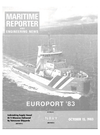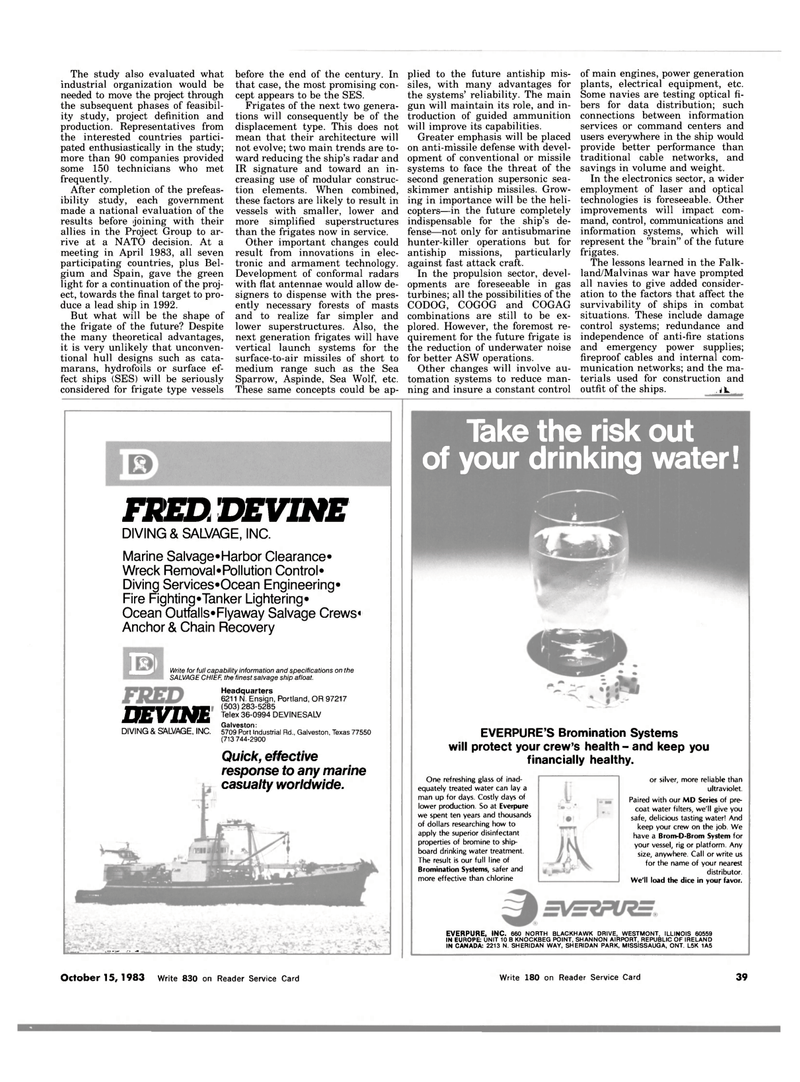
Page 41: of Maritime Reporter Magazine (October 15, 1983)
Read this page in Pdf, Flash or Html5 edition of October 15, 1983 Maritime Reporter Magazine
The study also evaluated what industrial organization would be needed to move the project through the subsequent phases of feasibil- ity study, project definition and production. Representatives from the interested countries partici- pated enthusiastically in the study; more than 90 companies provided some 150 technicians who met frequently.
After completion of the prefeas- ibility study, each government made a national evaluation of the results before joining with their allies in the Project Group to ar- rive at a NATO decision. At a meeting in April 1983, all seven participating countries, plus Bel- gium and Spain, gave the green light for a continuation of the proj- ect, towards the final target to pro- duce a lead ship in 1992.
But what will be the shape of the frigate of the future? Despite the many theoretical advantages, it is very unlikely that unconven- tional hull designs such as cata- marans, hydrofoils or surface ef- fect ships (SES) will be seriously considered for frigate type vessels before the end of the century. In that case, the most promising con- cept appears to be the SES.
Frigates of the next two genera- tions will consequently be of the displacement type. This does not mean that their architecture will not evolve; two main trends are to- ward reducing the ship's radar and
IR signature and toward an in- creasing use of modular construc- tion elements. When combined, these factors are likely to result in vessels with smaller, lower and more simplified superstructures than the frigates now in service.
Other important changes could result from innovations in elec- tronic and armament technology.
Development of conformal radars with flat antennae would allow de- signers to dispense with the pres- ently necessary forests of masts and to realize far simpler and lower superstructures. Also, the next generation frigates will have vertical launch systems for the surface-to-air missiles of short to medium range such as the Sea
Sparrow, Aspinde, Sea Wolf, etc.
These same concepts could be ap- plied to the future antiship mis- siles, with many advantages for the systems' reliability. The main gun will maintain its role, and in- troduction of guided ammunition will improve its capabilities.
Greater emphasis will be placed on anti-missile defense with devel- opment of conventional or missile systems to face the threat of the second generation supersonic sea- skimmer antiship missiles. Grow- ing in importance will be the heli- copters—in the future completely indispensable for the ship's de- fense—not only for antisubmarine hunter-killer operations but for antiship missions, particularly against fast attack craft.
In the propulsion sector, devel- opments are foreseeable in gas turbines; all the possibilities of the
CODOG, COGOG and COGAG combinations are still to be ex- plored. However, the foremost re- quirement for the future frigate is the reduction of underwater noise for better ASW operations.
Other changes will involve au- tomation systems to reduce man- ning and insure a constant control of main engines, power generation plants, electrical equipment, etc.
Some navies are testing optical fi- bers for data distribution; such connections between information services or command centers and users everywhere in the ship would provide better performance than traditional cable networks, and savings in volume and weight.
In the electronics sector, a wider employment of laser and optical technologies is foreseeable. Other improvements will impact com- mand, control, communications and information systems, which will represent the "brain" of the future frigates.
The lessons learned in the Falk- land/Malvinas war have prompted all navies to give added consider- ation to the factors that affect the survivability of ships in combat situations. These include damage control systems; redundance and independence of anti-fire stations and emergency power supplies; fireproof cables and internal com- munication networks; and the ma- terials used for construction and outfit of the ships. . dL
FRED DEVINE
DIVING & SALVAGE, INC.
Marine Salvage*Harbor Clearance*
Wreck Removal-Pollution Control-
Diving Services*Ocean Engineering*
Fire Fighting-Tanker Lightering*
Ocean Outfalls*Flyaway Salvage Crews«
Anchor & Chain Recovery
JE> Write for full capability information and specifications on the
SALVAGE CHIEF, the finest salvage ship afloat.
Headquarters 6211 N. Ensign, Portland, OR 97217 (503) 283-5285
Telex 36-0994 DEVINESALV
Galveston: 5709 Port Industrial Rd., Galveston, Texas 77550 (713 744-2900
DEVINE
DIVING & SALVAGE, INC.
Quick, effective response to any marine casualty worldwide. - -
Take the risk out of your drinking water!
EVERPURE'S Bromination Systems will protect your crew's health - and keep you financially healthy.
One refreshing glass of inad- equately treated water can lay a man up for days. Costly days of lower production. So at Everpure we spent ten years and thousands of dollars researching how to apply the superior disinfectant properties of bromine to ship- board drinking water treatment.
The result is our full line of
Bromination Systems, safer and more effective than chlorine or silver, more reliable than ultraviolet.
Paired with our MD Series of pre- coat water filters, we'll give you safe, delicious tasting water! And keep your crew on the job. We have a Brom-D-Brom System for your vessel, rig or platform. Any size, anywhere. Call or write us for the name of your nearest distributor.
We'll load the dice in your favor.
EVERPURE, INC. 660 NORTH BLACKHAWK DRIVE, WESTMONT, ILLINOIS 60559
IN EUROPE UNIT 10 B KNOCKBEG POINT, SHANNON AIRPORT, REPUBLIC OF IRELAND
IN CANADA: 2213 N. SHERIDAN WAV, SHERIDAN PARK, MISSISSAUGA, ONT. L5K 1A5
October 15, 1983 Write 830 on Reader Service Card Write 180 on Reader Service Card 39

 40
40

 42
42
